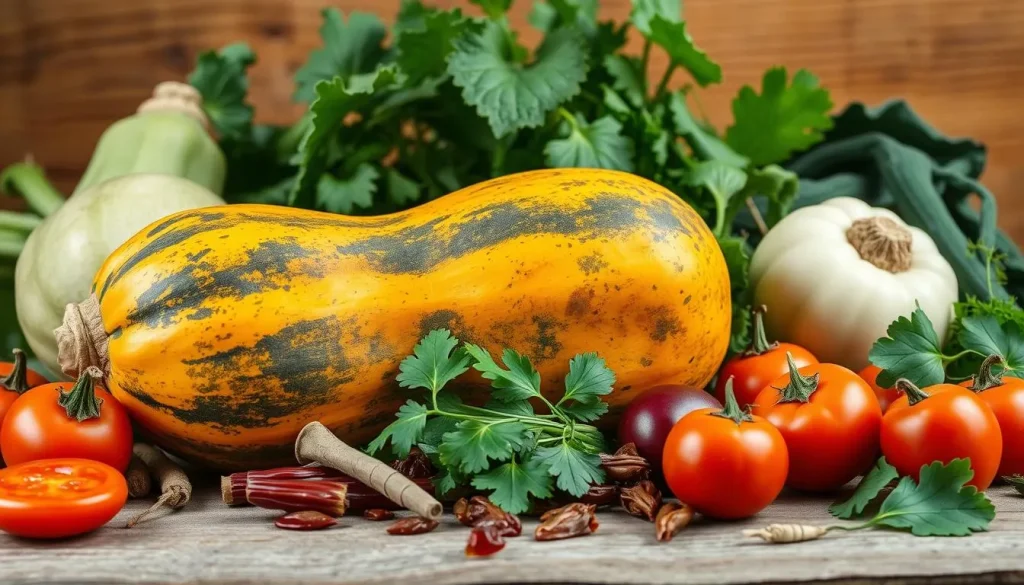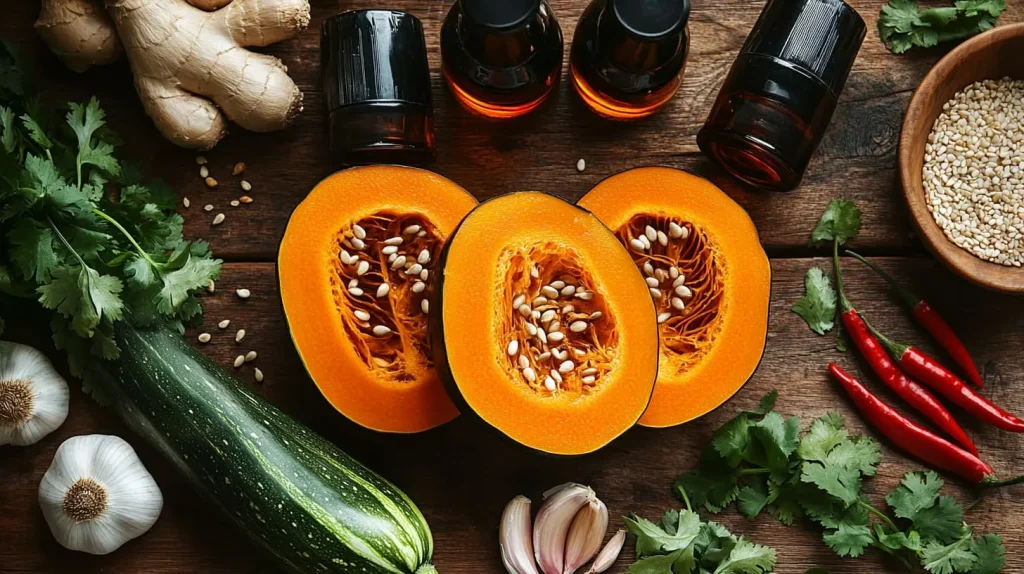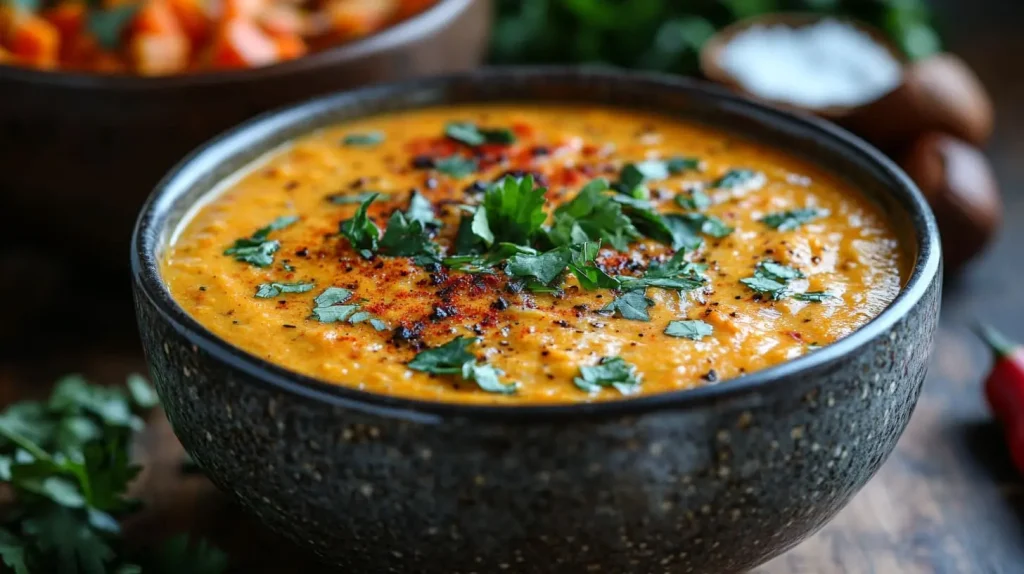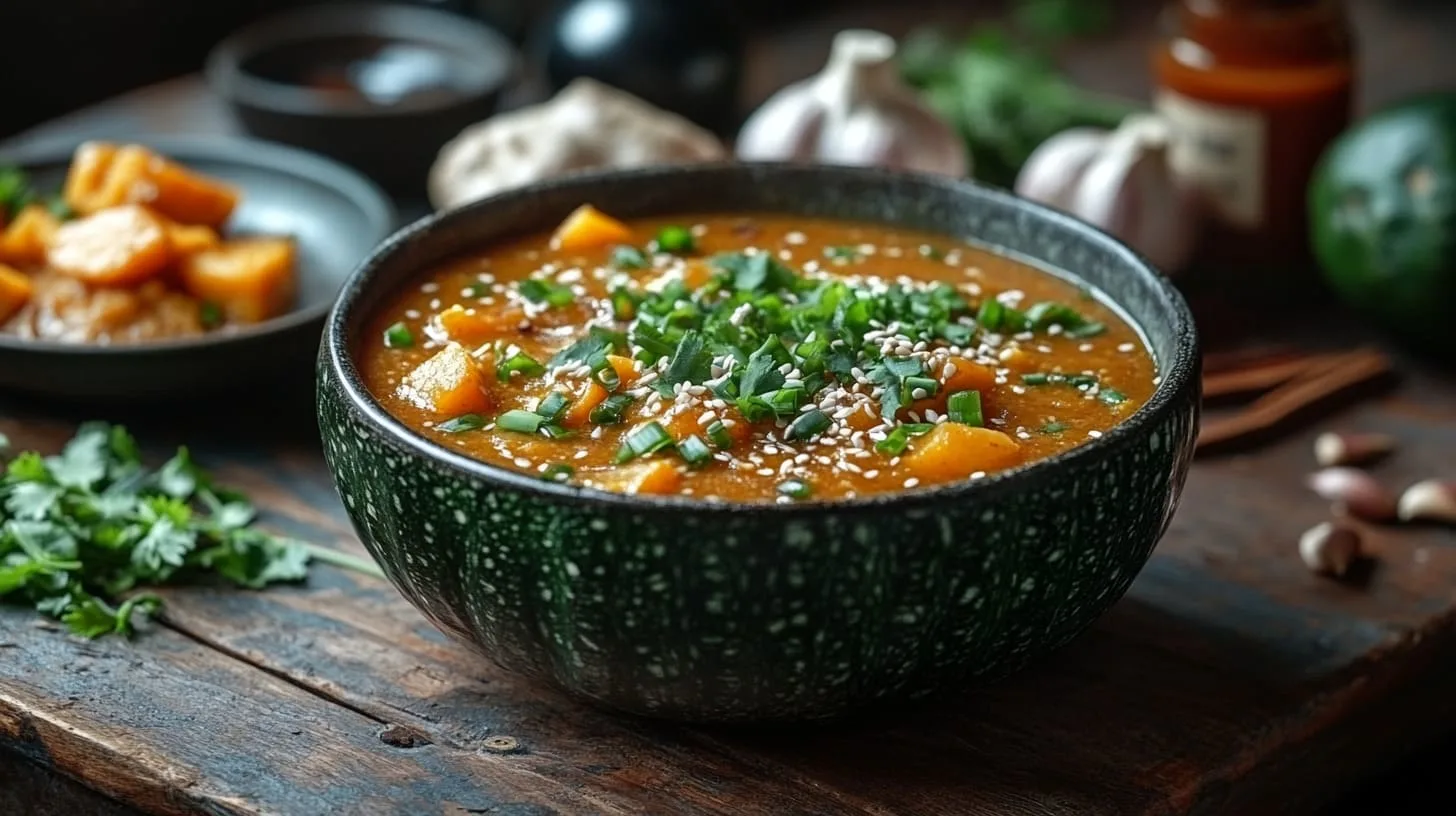I love cooking with plants and exploring Asian flavors. That’s why I’m sharing my favorite Chinese kabocha recipes dishes. Kabocha squash is sweet, creamy, and perfect for vegan meals.
Let’s dive into the world of kabocha. We’ll make delicious Chinese-inspired vegan recipes. Your taste buds will thank you.
Main Highlights
- Kabocha squash is a versatile Japanese pumpkin that adds sweetness and creaminess to vegan Chinese recipes
- Explore a variety of kabocha-based dishes, including soups, congee, and curry-spiced stews
- Learn how to properly prepare and cook kabocha squash for optimal texture and flavor
- Discover essential ingredients and cooking techniques for creating authentic Chinese-inspired vegan meals
- Gain tips for meal prepping, storage, and reheating kabocha-based dishes
Understanding Kabocha: The Key to Delicious Chinese Squash Recipes
Kabocha squash, also known as the Japanese pumpkin, is a key ingredient in Chinese squash recipes kabocha vegan dishes. It’s loved for its unique taste, creamy feel, and health benefits. This veggie is a key part of many vegan and vegetarian dishes in China.
The Nutritional Power of Kabocha Squash
Kabocha squash is full of vitamins and minerals that are good for you. It has lots of vitamin A, vitamin C, potassium, and magnesium. For a dessert packed with probiotics and nutrients, try our Kefir Sheet Cake Recipe for a sweet and healthy treat. These help your eyes, boost your immune system, and keep your muscles working right.
It’s also low in calories, which is great for those watching their weight or following a vegan diet.
How to Select and Store Fresh Kabocha
- Choose a kabocha that’s heavy for its size and has a hard, smooth rind.
- Stay away from kabocha with soft spots or cracks, as they’re bad.
- Keep kabocha in a cool, dry spot for up to 3 months to keep it fresh.
Simple Steps to Prepare Kabocha for Cooking
Getting kabocha ready for cooking is easy. Cut it in half, scoop out the seeds, then slice it into wedges or cubes. You can eat the skin, but peeling it is okay too.
Kabocha is great for roasting, steaming, or sautéing. It’s a key ingredient in many Chinese vegan and vegetarian dishes. For a unique seafood pairing, consider our Ahi Tuna Recipe Seared to create a gourmet fusion meal.

“Kabocha squash is a nutritional powerhouse that adds depth and creaminess to Chinese vegan dishes, while also being low in calories and highly versatile.”
Essential Ingredients for Chinese Squash Recipes Kabocha Vegan
When making vegan Chinese dishes with kabocha squash, you need some key ingredients. You’ll want creamy coconut milk and spices that smell great. These ingredients make your kabocha recipes taste amazing.
Coconut milk is very important for vegan kabocha recipes. It makes the dishes creamy and silky. Mixing it with vegetable broth adds a nice balance of flavors.
Fresh ginger and garlic are also key. They add depth and make the squash taste sweeter. They also give a warm, earthy flavor.
For spices, you can’t go wrong with curry powder and turmeric. Curry powder adds warmth and color. Turmeric is good for you and makes the dish vibrant.
Don’t forget to add fresh herbs like cilantro and lemongrass. They make the dish bright and refreshing.
Having these vegan Chinese ingredients and kabocha recipe essentials ready will help you make tasty plant-based meals. Kabocha squash is versatile and nutritious.
| Ingredient | Purpose |
|---|---|
| Coconut Milk | Provides a creamy, rich base for soups, stews, and curries |
| Vegetable Broth | Adds savory depth and balances the coconut milk |
| Fresh Ginger | Enhances the natural sweetness of kabocha and adds warmth |
| Garlic | Provides aromatic depth and complexity to the dishes |
| Curry Powder | Blends of warming spices that complement the kabocha flavor |
| Turmeric | Adds vibrant color and health benefits to the recipes |
| Cilantro | Brightens up the dish with its fresh, herbaceous notes |
| Lemongrass | Imparts a subtle citrus aroma and flavor to the kabocha dishes |
Using these vegan Chinese ingredients and kabocha recipe essentials lets you make many tasty dishes. They will impress your loved ones.

Creamy Kabocha Coconut Soup
Enjoy the cozy taste of kabocha coconut soup, a star among Chinese squash recipes kabocha vegan dishes. Complement your meal with our Chicken Breast Recipes for a balanced and protein-rich side. It mixes roasted kabocha squash’s sweetness with coconut milk’s creaminess. This vegan squash soup will warm your heart.
Key Aromatics and Spices
The soup’s flavor comes from its base. Onions, garlic, and ginger are sautéed first. Then, cumin and turmeric add their earthy taste. Together, they make a perfect mix with the squash.
Step-by-Step Cooking Instructions
- First, heat your oven to 400°F (200°C). Cut the kabocha squash in half, remove seeds, and roast on a baking sheet for 25-30 minutes.
- Next, sauté onions, garlic, and ginger in coconut oil until they smell good and are soft.
- Then, add the roasted squash, vegetable broth, coconut milk, cumin, turmeric, and a bit of cayenne pepper. Let it simmer for 15-20 minutes.
- Blend the soup until it’s smooth with an immersion blender or a high-speed blender.
- Finally, season it with salt, pepper, or lime juice to taste.
Serving Suggestions
Put the kabocha coconut soup in bowls. Top it with coconut milk, cilantro, and toasted pumpkin seeds or pistachios. It’s great as an appetizer or main dish with bread or salad.

“The creamy, velvety texture of this kabocha coconut soup is simply divine. It’s a comforting and nourishing dish that beautifully showcases the vibrant flavors of the kabocha squash.”
Traditional Chinese Kabocha Congee
Kabocha congee is a comforting vegan rice porridge loved in Chinese squash recipes kabocha vegan cuisine. It mixes the sweet taste of kabocha squash with jasmine rice’s smooth texture. This dish is simmered to perfection, making it a nourishing start to the day.
The secret to this dish is the right mix of ingredients. Rice is cooked with lots of water or broth, making it creamy. Kabocha squash puree adds a vibrant orange color and a velvety feel. Lemongrass, ginger, and white miso add to the flavor, blending umami and sweetness.
This dish is perfect for a comforting breakfast or a soothing snack. You can add toppings like crispy shallots or sesame oil to make it your own. Enjoy the warmth and nourishment of this vegan rice porridge, embracing Chinese culinary tradition.
The Korean pumpkin porridge recipe has 5 main ingredients: kabocha squash, sweet rice flour, salt, sugar, and water. It can be stored in the fridge for 3-4 days. Sweet rice flour is key for its smooth texture.
“The cooked kabocha squash is pureed in a blender to achieve a smooth consistency before adding it to the pot with water and sweet rice flour slurry.”
You can customize the Korean pumpkin porridge with toppings like sweet rice balls or pumpkin seeds. It’s vegan and gluten-free, using plant-based sweeteners and vegan-friendly toppings.
Curry-Spiced Kabocha Stew
Try the kabocha curry stew for a cozy and healthy meal. It mixes sweet kabocha squash with curry spices. This vegan vegan squash curry will make your taste buds happy.
Seasoning and Flavor Combinations
The key to this tasty stew is the spice mix. Start by cooking garlic, ginger, and onions in coconut oil. Next, add curry powder, cumin, and coriander for warm flavors. Finish with coconut milk and vegetable broth for creaminess.
Cooking Tips for Perfect Texture
- Cut the kabocha squash into bite-sized pieces to ensure even cooking.
- Simmer the stew until the squash is tender, then use an immersion blender or regular blender to create a smooth, velvety consistency.
- Adjust the thickness of the stew by adding more broth if it becomes too dense.
- Garnish with fresh cilantro leaves for a bright, herbaceous finish.
This kabocha curry stew is great for a cold day. You can enjoy it alone or with rice for a full meal.
Steamed Kabocha with Asian Seasonings
Discover the natural sweetness and creamy texture of kabocha squash. This simple steamed dish brings out the best in this Japanese pumpkin. A light seasoning with Asian flavors enhances its qualities.
To make the steamed kabocha, peel, seed, and cut it into 1-inch slices. Steam for 20-23 minutes until a fork goes through easily. Then, drain and place on a plate.
For the asian-seasoned topping, mix soy sauce, rice vinegar, and sesame oil. Pour this over the kabocha, making sure it’s evenly coated. Top with green onions and sesame seeds for extra flavor and looks.
The mix of soy sauce, rice vinegar, and sesame oil brings out the kabocha’s sweetness. It makes a balanced and satisfying dish. Enjoy the steamed kabocha warm, letting the flavors meld together.
This easy recipe showcases kabocha squash‘s versatility. It’s great as a side or main dish. The asian-seasoned kabocha impresses with its vibrant colors, comforting texture, and rich flavors.
Storage and Meal Prep Tips
Enjoying Chinese vegan squash dishes is easier with the right storage and meal prep. This ensures your homemade kabocha, acorn, or butternut squash stays fresh and tasty. Let’s look at the best ways to store and reheat these healthy squash recipes.
Freezing Instructions
Many Chinese squash dishes, like soups and stews, freeze well. Cool cooked dishes completely before putting them in airtight containers or freezer bags. Soups and stews can stay frozen for up to 2 months.
When you’re ready to eat, thaw them in the fridge overnight. Then, reheat them on the stovetop or in the microwave.
Reheating Guidelines
Reheat your frozen or chilled Chinese squash dishes on the stovetop or in the microwave. If it’s too thick, add a bit of broth, coconut milk, or water. This will help it get the right consistency again.
Don’t overheat, as it can make the dish lose its color and flavor. By following these tips, you can enjoy Chinese squash dishes for a long time. With a bit of planning, you’ll always have a tasty, healthy meal ready.
Common Cooking Challenges and Solutions
Cooking with kabocha squash, a favorite in Japan, can be tricky. But don’t let that stop you from using it in vegan recipes. Here are some common problems and easy fixes to help you get better at cooking kabocha:
Cutting Through the Hard Exterior
Kabocha’s hard skin makes it hard to cut. To make it easier, microwave the squash whole for 2-3 minutes before slicing. This will help you cut through without hurting yourself.
Preventing Scorching in Kabocha Congee
When making kabocha congee, it can scorch at the bottom. To avoid this, stir the congee often and keep the heat low. This will help it cook evenly.
Achieving a Smooth Texture in Soups
For smooth kabocha soups, use an immersion blender. Blend the soup right in the pot. Or, strain it through a fine-mesh sieve to get rid of any fibrous bits.
Balancing Flavors
Kabocha is sweet and nutty, which can overpower other flavors. To balance it, add seasonings slowly and taste as you go. Adjust the salt, spices, or sweetness to your liking.
Remember these kabocha cooking tips to solve any vegan squash recipe troubleshooting. You’ll enjoy making and eating your kabocha-based dishes.
Recipe Variations and Substitutions
Trying out different kabocha recipe alternatives and vegan squash substitutions can open up a lot of possibilities. If you can’t find fresh kabocha squash, butternut squash or pumpkin works well as a substitute. They offer a similar taste and texture.
For a creamy texture without nuts, use cashew milk instead of coconut milk. Cooking without oil is easy. Just use water or vegetable broth to sauté your ingredients.
Don’t be afraid to mix up your curry powder or make your own spice blend. This way, you can add unique flavors to your dishes. Kabocha squash is very versatile, so you can try many different recipes.
| Ingredient | Substitution | Nutritional Information (per serving) |
|---|---|---|
| Kabocha Squash | Butternut Squash, Pumpkin | Calories: 241 kcalCarbohydrates: 26gProtein: 4gFat: 15g |
| Coconut Milk | Cashew Milk | Saturated Fat: 2gPolyunsaturated Fat: 2gMonounsaturated Fat: 10g |
| Cooking Oil | Water, Vegetable Broth | Sodium: 313mgPotassium: 920mgFiber: 5g |
| Curry Powder | Homemade Spice Blend | Vitamin A: 3319 IUVitamin C: 34mgCalcium: 93mgIron: 3mg |
By trying out different recipe variations and substitutions, you can get creative in the kitchen. This way, you can make dishes that everyone can enjoy, no matter their dietary needs. So, go ahead and explore the delicious world of kabocha squash recipes.
Conclusion
Kabocha squash is amazing in Chinese kabocha recipes dishes. It makes creamy soups and hearty stews. Its sweet flavor and creamy texture are perfect for plant-based recipes.
It can be used in many vegan Chinese squash dishes. You can leave the skin on or peel it off. This way, it fits many diets.
Try making fragrant coconut soups or spice stews with it. Kabocha squash is full of nutrients and offers endless possibilities.
Keep trying new vegan kabocha recipes. Let the squash’s unique qualities shine. Adjust seasonings and cooking methods to your liking. Soon, you’ll find your favorite way to enjoy kabocha squash.
FAQ
What is kabocha squash?
Kabocha squash is also known as Japanese pumpkin. It’s used in Chinese cooking. It tastes sweet, like pumpkin or sweet potato.
What are the nutritional benefits of kabocha squash?
It’s full of vitamins A and C, fiber, and antioxidants. It’s great for vegan recipes because it’s healthy.
How do I select and store fresh kabocha squash?
Pick squash that’s heavy and has no soft spots. Keep it in a cool, dry place for up to 3 months.
How do I prepare kabocha squash for cooking?
Cut it in half, remove seeds, and slice into wedges. The skin is edible when cooked. You can peel it if you prefer.
What are the key ingredients used in vegan kabocha recipes?
Ingredients include coconut milk, vegetable broth, ginger, garlic, and spices. Fresh herbs like cilantro and lemongrass are also used.
How do I make creamy kabocha coconut soup?
Roast the squash, then blend it with coconut milk and broth. Add onion, garlic, and ginger. Season with cumin and turmeric.
How do I prepare traditional Chinese kabocha congee?
Make a rice porridge with jasmine rice, kabocha purée, and lemongrass and ginger. Use a 1:9 rice-to-liquid ratio with water and broth.
How do I make a curry-spiced kabocha stew?
Sauté aromatics, then add diced kabocha, coconut milk, and curry powder. Simmer until tender, then blend for smoothness.
How do I store and reheat cooked kabocha dishes?
Store in the fridge for up to 5 days or freeze for 2 months. Thaw and reheat on the stovetop or microwave, adding liquid if needed.
What are some common cooking challenges with kabocha squash?
Cutting can be hard (microwave briefly to soften). Scorching in congee (stir often and adjust heat). Achieving smooth soups (use an immersion blender or strain).
What substitutions can I use for kabocha squash?
Use butternut squash or pumpkin if kabocha is not available. For creaminess, use cashew milk instead of coconut milk. For oil-free cooking, sauté in water or broth.

